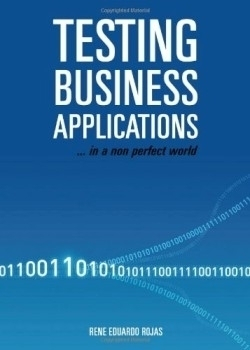Testing Business Applications
According to statistics, the majority of people who work in testing have never been formally trained. Testing Business Applications is written for quality engineers at any level, as well as other managers who work with quality engineers or are involved with testing. Rene Eduardo Rojas offers sincere and practical guidance as a consultant who has experienced what works and what doesn’t in terms of applications testing. His book specifically deals with the aspects of compliance testing.
What sets this book apart from others about software testing is that it is based on the real world, not theoretical concepts for flawless execution. It’s a compilation of lessons learned. For example, organizational politics is a non-technical factor that test managers must be aware of and deal with effectively. “In the non-perfect world test projects can be considered successful not by the actual work, but by the way that the relationship with the key parties have been politically managed,” Rojas writes.
Don’t expect to find detailed how-to testing process information here. Rather, each chapter focuses on practical advice and avoiding pitfalls. The author shares standard practices proven to be generally effective, but he doesn’t take a one-size-fits-all approach. He acknowledges that certain methodologies work better in some companies and situations than in others. Rojas views “best practices” as situational. “Best practices are not an absolute and they are not an indicator of guaranteed success,” he writes. “…they should be understood as methods and practices that have proved to be effective in particular circumstances…”
Rojas cautions that new development methodologies like Agile, while perhaps appropriate for some circumstances, may not work as effectively as traditional methods in other cases—like large, complex projects—and the absence of detailed documentation could be a factor for testers to deal with.
The book also discusses the challenges faced by quality engineers and test managers, basic testing concepts, typical test types, testing implementation, automation concepts, and the main duties of test team members. Figures include basic diagrams, flow charts, analysis tables, specifications, and tracking report templates. Especially useful are the key points or cautions highlighted in bold that are scattered throughout the book. The writing makes this technical topic easy to understand, but professional proofreading would give the book a more polished, professional appearance.
Rojas has a degree in computer science from Pontificia Universidad Catolica de Chile and experience in international projects throughout Asia, Australia, South Africa, Europe, and the United States. He has worked as a test manager and a test consultant. His twenty years of experience with projects and companies of varying sizes lends valuable expertise to this subject.
Disclosure: This article is not an endorsement, but a review. The publisher of this book provided free copies of the book and paid a small fee to have their book reviewed by a professional reviewer. Foreword Reviews and Clarion Reviews make no guarantee that the publisher will receive a positive review. Foreword Magazine, Inc. is disclosing this in accordance with the Federal Trade Commission’s 16 CFR, Part 255.

